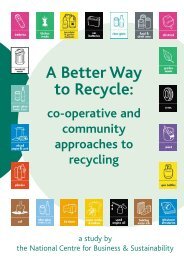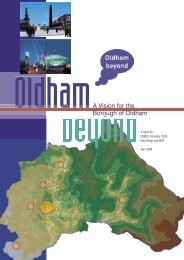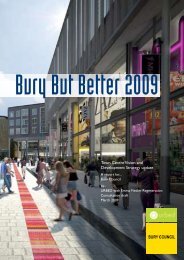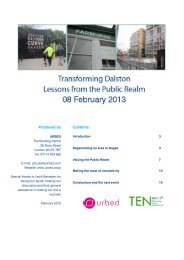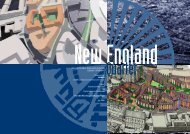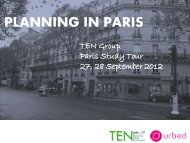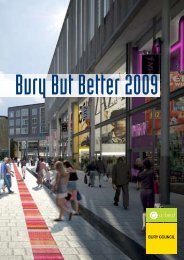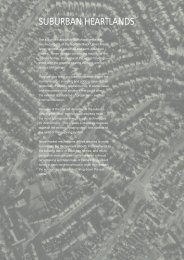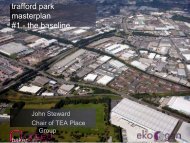URBAN DESIGN FRAMEWORK The University of Liverpool - Urbed
URBAN DESIGN FRAMEWORK The University of Liverpool - Urbed
URBAN DESIGN FRAMEWORK The University of Liverpool - Urbed
You also want an ePaper? Increase the reach of your titles
YUMPU automatically turns print PDFs into web optimized ePapers that Google loves.
<strong>University</strong> <strong>of</strong> <strong>Liverpool</strong>: UDF1:2 - <strong>The</strong> <strong>University</strong> ChallengeUniversities operate in an ever changingworld. Staff and students are becoming moredemanding, space requirements are changingand the environment in which they operate isbecoming more competitive. <strong>The</strong> masterplanmust respond to these challenges.<strong>The</strong> <strong>University</strong>’s needs are changing and the way itoperates today is very different from the situation inthe 1940s when the last major masterplan for thecampus was undertaken by Lord Holford. <strong>The</strong> newmasterplan must respond to these changing needs:<strong>The</strong> knowledge economy is now central to theeconomic success <strong>of</strong> cities so that universitiesneed to be embedded in the economy <strong>of</strong> the city.Student numbers have increased from lessthan 5% <strong>of</strong> young people in the 1940s to acurrent target <strong>of</strong> 50%. <strong>The</strong> size <strong>of</strong> coursesand the number <strong>of</strong> students on campus hasincreased hugely since the 1980s although thishas now levelled <strong>of</strong>f.Overseas students are crucial to the academiclife and finances <strong>of</strong> the <strong>University</strong> and thecampus needs to be attractive to them.<strong>The</strong>re are far more universities than thereused to be. Students are attracted to the brightlights <strong>of</strong> cities like <strong>Liverpool</strong> but parents remainconcerned about safety and crime. <strong>The</strong> campustherefore needs to provide a safe environment.Course types are evolving with the expansion<strong>of</strong> vocational courses and an increasingdiversity <strong>of</strong> learning and teaching formatsincluding full and part-time courses, distancelearning and use <strong>of</strong> on-line delivery.<strong>University</strong> finance depends on researchratings and this depends on attracting the bestacademics. <strong>The</strong> campus must therefore be agood place to work.<strong>The</strong>re is increasing concern about theenvironment and universities are expected totake the lead in carbon reduction strategies.Initiatives like Harvard’s Green Campus showhow this can project a positive image.Universities rely on conferences and otheractivities to generate revenue. This requiresmodern conference venues as well asaccommodation, catering and parkingprovision.Technology is changing rapidly; in the lastdecade universities installed rooms full <strong>of</strong>computers for students. However, with theavailability <strong>of</strong> affordable, portable computingstudents are increasing flexible in where andhow they can work.Tuition fees are helping to fund improvedaccommodation but have also changed therelationship between students and universitieswith the former acting more like customersand the latter increasingly eager to impress.All <strong>of</strong> this means that universities need to makesure that their buildings and the environmentson their campus are memorable and welcoming.People’s expectations <strong>of</strong> their university arebecoming more aspirational. Estates strategies areno longer just pragmatic, functional programmesto house the <strong>University</strong>’s activities but are nowcrucial to the success <strong>of</strong> their institution.<strong>The</strong>se issues are also being addressed byAmerican Universities. As part <strong>of</strong> this the not-forpr<strong>of</strong>itorganisation ‘Project for Public Spaces’ (whoworked with URBED in the 1980s) have set out sixobjectives that a good university campus shouldaspire to achieve. <strong>The</strong>se provide a good foundationfor the <strong>Liverpool</strong> <strong>University</strong> Masterplan:1. Bring people and ideas together<strong>The</strong> boundaries between disciplines are breakingdown. In today’s institution, the managementschool, for example needs to interact with theteaching hospital, the linguists with the scientists.Students also need to interact with each other andin turn the entire <strong>University</strong> needs to interact withthe broader city and community.Such encounters help generate new ideas, thevery currency <strong>of</strong> the knowledge economy. <strong>The</strong>campus needs to be designed to create spacefor these interactions. For all <strong>of</strong> the importance<strong>of</strong> virtual worlds, face-to-face communicationremains vital and the campus needs to includelively inviting public spaces to encourageinteraction.



